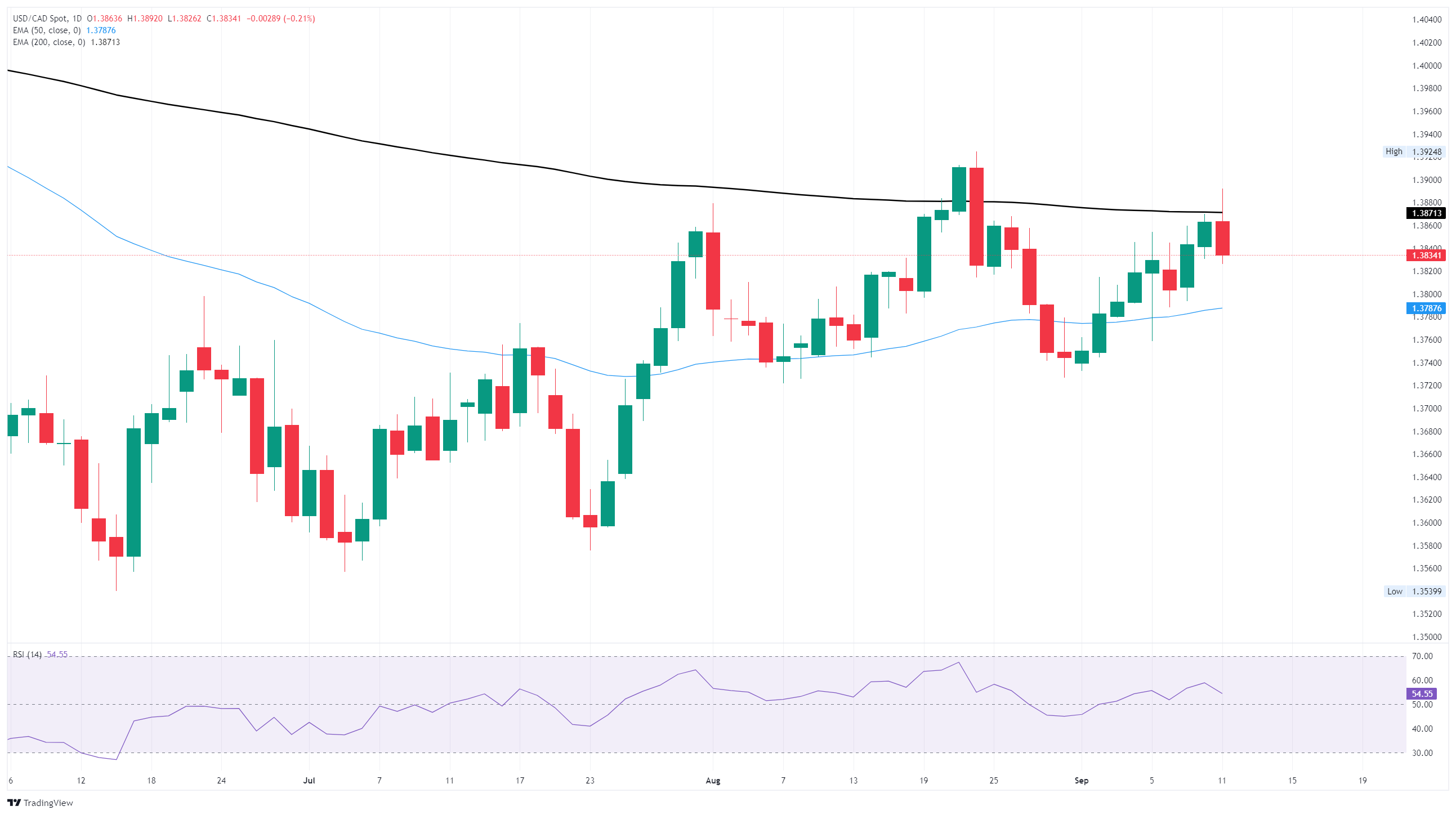Canadian Dollar finds a foothold on Thursday, paring losses on a technical bounce

- The Canadian Dollar rose 0.2% against the US Dollar on Thursday.
- USD/CAD tested the 200-day EMA for the second time in three weeks.
- US CPI inflation sparked a risk-on market push, forcing the Greenback lower.
The Canadian Dollar (CAD) found firm bids on Thursday, springing back from a three-week low and chalking in another technical rejection from the 200-day Exponential Moving Average (EMA) against the US Dollar (USD). US Consumer Price Index (CPI) inflation rose in August, but not enough to knock investors off of their expectations for an interest rate cut from the Federal Reserve (Fed) next week.
The Canadian Dollar’s newfound strength comes on the back of fresh US Dollar weakness, rather than any intrinsic strength. Canadian money markets are still going strong, and yields on Canadian bonds declined through the midweek, helping to bolster general Loonie sentiment on Thursday, yet the Canadian economy is still entrenched in the beginnings of a recession, and economic indicators are pointing towards further easing required from the Bank of Canada (BoC) on the horizon.
Daily digest market movers: US CPI inflation drags down Greenback, bolstering Canadian Dollar
- The Canadian Dollar gained one-fifth of one percent on Thursday, clawing back from a 0.2% loss early in the day.
- Fresh bets of a trio of Fed funds rate cuts before the end of the year knocked the US Dollar lower, driving up the Loonie.
- US CPI annualized inflation rose to 2.9% YoY in August, still well above the Fed’s 2% target but not high enough to crimp Fed rate cut bets in the face of withering labor market data.
- Loonie gains could be crimped moving forward: The BoC is similarly expected to act on interest rates soon, which will limit differential support for the Canadian Dollar.
- Too many near-term reversals has left the Canadian Dollar stuck in a technical trap against the US Dollar.
Canadian Dollar price forecast
The Canadian Dollar’s fresh strength on Thursday snapped a two-day losing streak, forcing a strong technical rejection from the 200-day Exponential Moving Average (EMA) near 1.3870 on the USD/CAD chart. The Loonie continues to trade in the middle of a congestion zone against the US Dollar as medium-term momentum struggles to get a new trend going.
USD/CAD daily chart

Canadian Dollar FAQs
The key factors driving the Canadian Dollar (CAD) are the level of interest rates set by the Bank of Canada (BoC), the price of Oil, Canada’s largest export, the health of its economy, inflation and the Trade Balance, which is the difference between the value of Canada’s exports versus its imports. Other factors include market sentiment – whether investors are taking on more risky assets (risk-on) or seeking safe-havens (risk-off) – with risk-on being CAD-positive. As its largest trading partner, the health of the US economy is also a key factor influencing the Canadian Dollar.
The Bank of Canada (BoC) has a significant influence on the Canadian Dollar by setting the level of interest rates that banks can lend to one another. This influences the level of interest rates for everyone. The main goal of the BoC is to maintain inflation at 1-3% by adjusting interest rates up or down. Relatively higher interest rates tend to be positive for the CAD. The Bank of Canada can also use quantitative easing and tightening to influence credit conditions, with the former CAD-negative and the latter CAD-positive.
The price of Oil is a key factor impacting the value of the Canadian Dollar. Petroleum is Canada’s biggest export, so Oil price tends to have an immediate impact on the CAD value. Generally, if Oil price rises CAD also goes up, as aggregate demand for the currency increases. The opposite is the case if the price of Oil falls. Higher Oil prices also tend to result in a greater likelihood of a positive Trade Balance, which is also supportive of the CAD.
While inflation had always traditionally been thought of as a negative factor for a currency since it lowers the value of money, the opposite has actually been the case in modern times with the relaxation of cross-border capital controls. Higher inflation tends to lead central banks to put up interest rates which attracts more capital inflows from global investors seeking a lucrative place to keep their money. This increases demand for the local currency, which in Canada’s case is the Canadian Dollar.
Macroeconomic data releases gauge the health of the economy and can have an impact on the Canadian Dollar. Indicators such as GDP, Manufacturing and Services PMIs, employment, and consumer sentiment surveys can all influence the direction of the CAD. A strong economy is good for the Canadian Dollar. Not only does it attract more foreign investment but it may encourage the Bank of Canada to put up interest rates, leading to a stronger currency. If economic data is weak, however, the CAD is likely to fall.







